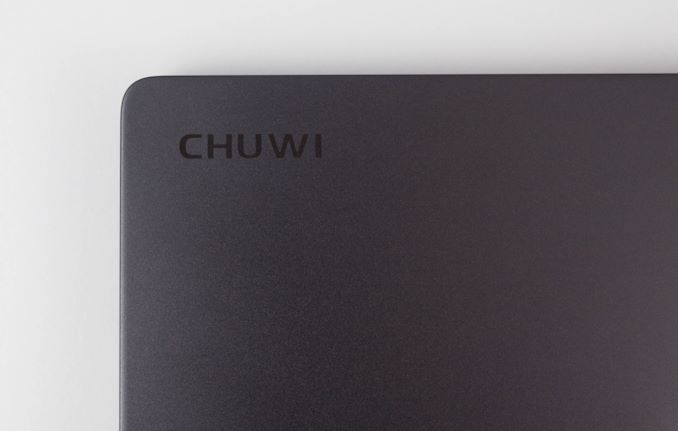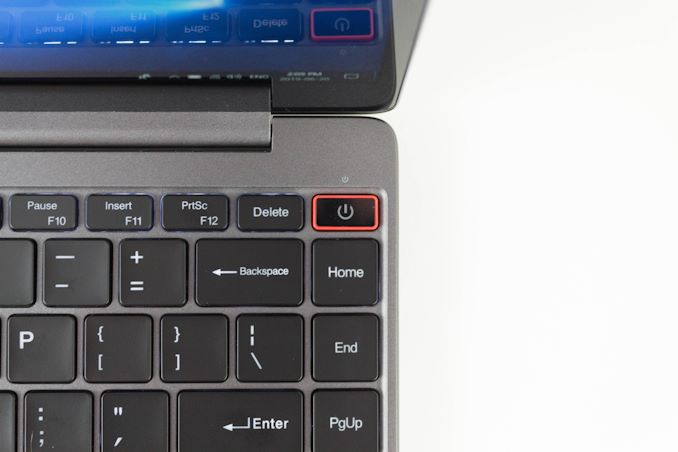The Chuwi AeroBook Review: One Small Step For Chuwi
by Brett Howse on June 21, 2019 8:00 AM ESTFinal Words
Chuwi took a bit of a gamble moving from the Atom platform they were comfortable with, to Intel’s Y series of Core processors, and overall, it is a gamble that has paid off well. Even the Skylake-era Core m3-6Y30 found in the AeroBook offers a noticeable improvement in performance compared to the previous LapBooks we have tested from the manufacturer, which featured Atom-based processors. The GPU gets an especially large bump, moving from 12 Execution Units on Atom, to 24 on Core, and although the GPU is still anemic for gaming tasks, the extra performance is still welcome.
Chuwi has mimicked the MacBook with their design, and it’s hard to fault them on the execution. The aluminum exterior offers a premium feel, even though some of the notebook is still plastic. Chuwi also offers a modern slim-bezel design, which shrinks the 13.3-inch notebook and makes it even more portable. They’ve done that while keeping the webcam in the correct location though, so it’s nicely achieved.
The laptop is very light, coming in at 1.26 kg / 2.77 lbs, and coupled with the thin design and small bezels, makes the AeroBook very easy to take with you. When you consider the price, it’s very impressive that they’ve designed such a great looking device while still keeping it thin and light.
Not all was done well though. The display, while continuing to be a 1920x1080 IPS panel like they offer on some of their other notebooks, is well off the mark in terms of color accuracy. Its only real saving grace is that it is able to achieve the sRGB gamut, but that’s a low bar. A similarly priced Surface Go from Microsoft comes with an individually calibrated display. Coupled with the poor accuracy is mediocre contrast. The 1920x1080 IPS is appreciated, but also expected in this price range; and other than the resolution and wide viewing angles, the rest of the display is sub-par.
Chuwi has often struggled with battery life, which could be somewhat attributed to smaller battery capacities to hit their price target. That is certainly the case here again, with just a 38 Wh battery when the typical 13.3-inch Ultrabook has closer to 50 Wh or more. Furthermore, Chuwi has not done any real work on the platform power draw, and the Chuwi AeroBook has some of the highest idle power draw of any notebook in its class, so when coupled with a smaller than average battery, overall battery life is well off the mark.
There are other areas where Chuwi has saved money, but they aren’t as big of an impact. The 1x1 wireless solution is there as a cost-savings measure, but they’ve at least gone with the Intel Wireless adapter, meaning it’s slow, but rock solid. Chuwi has also opted for a slower SATA SSD, but considering most of the competition in this price range would still offer a spinning drive, or eMMC storage, the 256 GB SSD is most certainly welcome. Chuwi also makes it incredibly easy to replace the SSD with a dedicated cover on the bottom of the laptop for easy access. The single-channel RAM is also a cost-saving measure, but at least there’s a solid 8 GB of memory, meaning this laptop isn’t going to run out of RAM on most light tasks.
There’s no doubt that the AeroBook is an improvement over some of the other Chuwi models, while still keeping a great design, but, and this is always the key, Chuwi has to be especially careful when their price creeps up, because they are no longer competing against poor machines. But they’ve continued to offer the value-add bonues compared to their competition. The AeroBook would be something I would compare against the original ASUS Core M laptop – the UX305 – where they offer enough RAM and storage to make this device usable, but keep the price down. The AeroBook doesn’t quite hit the same level of fit and finish of the ASUS Zenbook, but offers similar performance and specifications at hundreds of dollars less.
If you need great battery life, this Chuwi AeroBook is not for you. But for a general purpose laptop, it offers a great design, reasonable performance, and as much RAM and SSD storage as machines that cost quite a bit more. So when you factor that in, the $499 MSRP is still rather attractive. If Chuwi is going to continue to try and compete in higher brackets, they will need to address some of their faults, but at the $500 range, the Chuwi AeroBook still offers a lot for the price.













51 Comments
View All Comments
HStewart - Friday, June 21, 2019 - link
I have purchase a Chuwi tablet and would say it was very cheap and I would never purchase one for $500. This uses 2 generations old bottom of line Intel Y processor and very soon to 3 generations old. My guess is that they are trying to monopolize on old hardware.My 3 year old Samsung TabPro S has similar cpu and in better form factor than this - are we sure this was a new computer - but than again Chuwi always used outdated components which to be honest gives a bad name out there.
pjcamp - Friday, June 21, 2019 - link
"Chuwi has often never done well on battery life..."Often never?
PixyMisa - Sunday, June 23, 2019 - link
In this case, yes.Hog54 - Friday, June 21, 2019 - link
Im on a Asus laptop that has a AMD RYZEN 2500u, Nvidia 1050 graphics,8 gig of ram,and a 256 ssd that I paid the same price for 3 months ago.:)Xpl1c1t - Saturday, June 22, 2019 - link
Bought a Huawei Ryzen 2500U Matebook D, $450. Im mainly a desktop user, but this laptop is probably the most functional laptop I've used. Running Plasma Wayland desktop for most taks (still need windows for MATLAB and SPICE). Havent been this convinced that I own a great mobile product since purchasing the Samsung NC20 (Via Nano powered) netbook ages ago and reworking the keyboard to DVORAK to evaluate the claimed benefits (it is better, wish i could rework this keyboard).The level of competition in the low/midrange mobile segment makes me wonder why anyone would mess with premium segment mobile products given the minimal performance gap. Egotism I guess.
HP, Razer, Dell, Apple - I see most college students around me using these products, but cant help shaking my head when considering their markup over price-competitive brands. My experience with HP laptops is that they have fragile glass coverings on their touchscreens, Razer is basically adopting the premium Apple tax mentality which caters to their market segments, Dell products are probably the most durable - though XPS machines are way overpriced. I strongly suspect that, despite the fact that all these machines are not manufactured domestically, that the markup over identically specc'd machines from non-domestic brands is simply buffering the inevitable collapse of their niche domestic markets. The proposition that the domestic engineering of a laptop is significantly superior to non-domestic engineering is no longer legitimate. Guess this is why people want to make america great again?
bji - Saturday, June 22, 2019 - link
I guess no one else is as smart as you huh?Perhaps you should read and understand the selection mechanisms that go into consumer choices. Not everyone wants what you want, and other people value aspects of products that you may not care about. It's kind of obvious if you think about it. Have you actually thought about it? Or are you more comfortable making ego-stroking assumptions?
Sorry I just cannot read another smug Anandtech post about how much smarter the poster is than everyone else with regards to product choices. It is soooo old and increasingly annoying every time it happens.
Xpl1c1t - Sunday, June 23, 2019 - link
I'm not proposing that I am smart, but thank you for educating me about your opinion."The proposition that the domestic engineering of a laptop is significantly superior to non-domestic engineering is no longer legitimate."
That is my proposal. Eat it. What, do you work for HP? Raking in the screen repair bucks? Yeah... guess I cant get my Huawei repaired domestically, but im not concerned about the glass shattering any time soon.
oRAirwolf - Sunday, June 23, 2019 - link
I got one of these off of the IndieGoGo campaign for $429. It's a nice laptop for the money. I agree that the battery is too small.Some complaints:
The screen has a very yellow tint to it. I have tried adjusting the color temp in the Intel control panel, but it's just not great. I ordered a SpyderX Pro and am going to play with it more.
The backlight on the keyboard does not turn on with the laptop. You have to turn it on every time you power on the laptop. It would be really nice if it remembered it's setting.
The backlight on the keyboard does not turn off when you turn off the laptop.
The BIOS is completely unlocked and has options for many features that do not exist. It makes it pretty difficult to make any changes.
Lord of the Bored - Monday, June 24, 2019 - link
"The backlight on the keyboard does not turn off when you turn off the laptop."All I can say to that is: Haha what.
...
How do you mess that up?
Spunjji - Wednesday, June 26, 2019 - link
Agreed, that's pretty damn special!